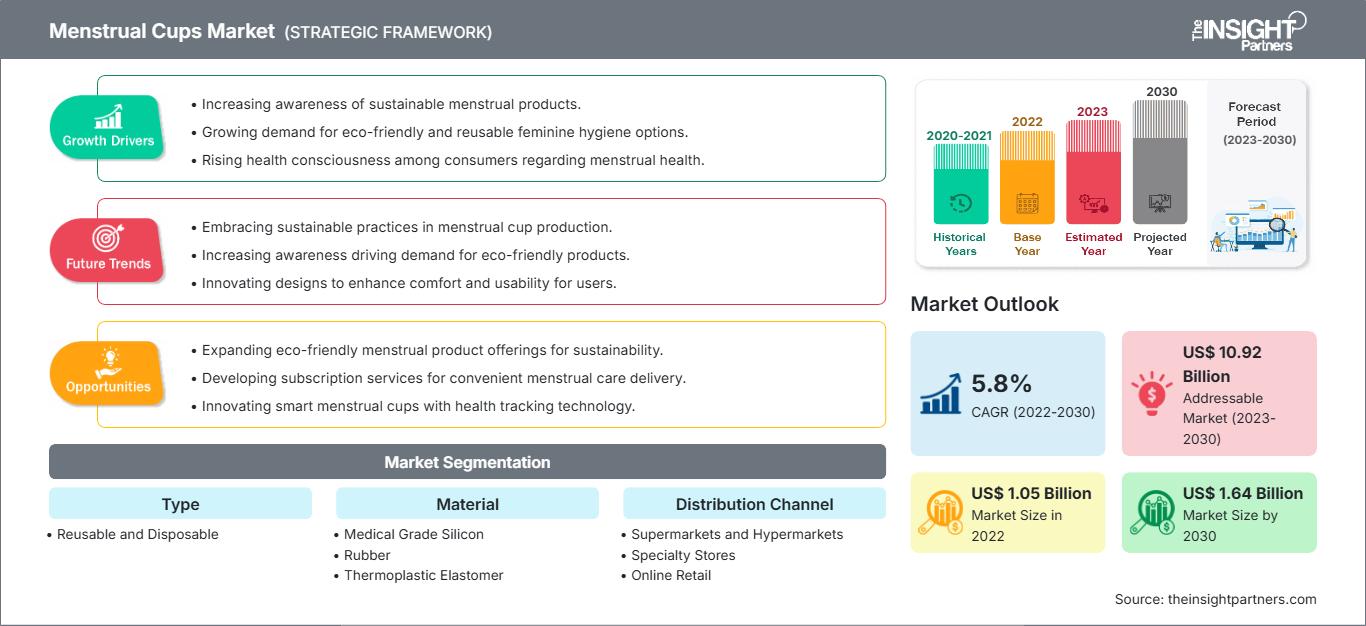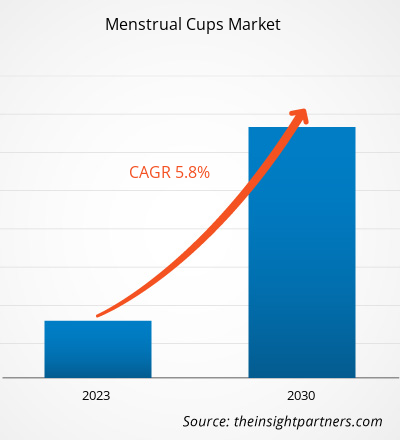[Rapporto di ricerca] Il mercato delle coppette mestruali è stato valutato a 1.050,81 milioni di dollari nel 2022 e si prevede che raggiungerà i 1.644,06 milioni di dollari entro il 2030; si stima che registrerà un CAGR del 5,8% dal 2022 al 2030.
Approfondimenti di mercato e punto di vista degli analisti:
Le coppette mestruali sono dispositivi riutilizzabili a forma di campana, progettati per l'igiene femminile durante le mestruazioni. Solitamente realizzate in silicone o gomma di grado medicale, queste coppette vengono inserite nella vagina per raccogliere il flusso mestruale anziché assorbirlo come i tradizionali assorbenti. Creano una tenuta stagna per prevenire le perdite e possono essere indossate fino a 12 ore prima di dover essere svuotate, offrendo un'alternativa sostenibile ed economica ai prodotti monouso. Le coppette mestruali stanno guadagnando popolarità per i loro benefici ambientali e il risparmio sui costi a lungo termine rispetto alle tradizionali opzioni per l'igiene mestruale.
Fattori di crescita e sfide:
La crescente domanda di prodotti mestruali sostenibili è uno dei principali motori che spinge il mercato delle coppette mestruali. Negli ultimi anni, si è assistito a una svolta globale verso la sostenibilità, con i consumatori sempre più consapevoli dell'impatto ambientale dei tradizionali prodotti mestruali usa e getta. Assorbenti e tamponi tradizionali contribuiscono in modo significativo allo spreco di plastica e la loro produzione comporta il consumo di risorse ed energia. Ogni anno, una donna media getta nella spazzatura quasi 150 chilogrammi di rifiuti non biodegradabili. Solo in India, circa 121 milioni di donne e ragazze utilizzano in media otto assorbenti monouso e non compostabili al mese, generando 1,021 miliardi di rifiuti di assorbenti al mese, 12,3 miliardi di rifiuti di assorbenti all'anno e 113.000 tonnellate di rifiuti mestruali all'anno. Le coppette mestruali si sono affermate come una scelta di primaria importanza, in quanto le persone cercano alternative ecologiche grazie alla loro natura riutilizzabile. Questa maggiore consapevolezza ambientale spinge i consumatori a optare per prodotti che riducono al minimo l'impatto ambientale, aumentando la domanda di coppette mestruali.
La crescente domanda di prodotti mestruali sostenibili è strettamente legata a un movimento più ampio che promuove la salute e il benessere delle donne. I consumatori stanno dando sempre più priorità a prodotti che non siano solo rispettosi dell'ambiente, ma anche sicuri e benefici per la loro salute. Le coppette mestruali, tipicamente realizzate in silicone medicale, gomma o elastomeri termoplastici, sono considerate sicure e igieniche, riducendo il rischio di irritazioni e reazioni allergiche spesso associate ai prodotti tradizionali. L'allineamento delle coppette mestruali con la sostenibilità ambientale e la salute delle donne contribuisce al loro fascino, fungendo da motore della loro crescente popolarità.
Personalizza questo rapporto in base alle tue esigenze
Potrai personalizzare gratuitamente qualsiasi rapporto, comprese parti di questo rapporto, o analisi a livello di paese, pacchetto dati Excel, oltre a usufruire di grandi offerte e sconti per start-up e università
Mercato delle coppette mestruali: Approfondimenti strategici

-
Ottieni le principali tendenze chiave del mercato di questo rapporto.Questo campione GRATUITO includerà l'analisi dei dati, che vanno dalle tendenze di mercato alle stime e alle previsioni.
La richiesta di sostenibilità nei prodotti per l'igiene mestruale è stata amplificata da vari gruppi di sostegno, ONG e iniziative governative che mirano a sensibilizzare sull'impatto ambientale delle opzioni usa e getta. Le campagne che promuovono un ciclo mestruale sostenibile sono state fondamentali per educare il pubblico sui benefici delle alternative riutilizzabili come le coppette mestruali. La crescente visibilità e il sostegno a pratiche mestruali sostenibili contribuiscono a un cambiamento positivo negli atteggiamenti dei consumatori, favorendo una maggiore accettazione e adozione delle coppette mestruali.
La domanda di prodotti per l'igiene mestruale sostenibili è alimentata anche da una generazione più giovane di consumatrici che dà priorità a scelte eco-consapevoli. I Millennial e la Generazione Z, in particolare, guidano la domanda di prodotti sostenibili ed etici in vari settori, tra cui la cura della persona. La consapevolezza e le preferenze di questi gruppi demografici influenzano le tendenze del mercato e le coppette mestruali, essendo un'opzione sostenibile e lungimirante, si allineano bene ai loro valori. Con la continua crescita del potere d'acquisto di questa fascia demografica, aumenterà anche la domanda di coppette mestruali, rafforzandone la posizione sul mercato come prodotto leader per il ciclo mestruale sostenibile.
Tuttavia, la percezione e la scarsa consapevolezza dei consumatori rappresentano un ostacolo significativo al mercato delle coppette mestruali, con un impatto sui tassi di adozione a livello globale. Molte persone rimangono disinformate sui benefici delle coppette mestruali a causa della mancanza di campagne di informazione e sensibilizzazione complete. La scarsa familiarità con il prodotto e i suoi vantaggi, come il rapporto qualità-prezzo, il ridotto impatto ambientale e la maggiore durata d'uso, contribuisce alla riluttanza delle potenziali utilizzatrici a passare dai prodotti tradizionali per il ciclo mestruale. Questa mancanza di conoscenza può portare a idee sbagliate e inibizioni, ostacolando una più ampia accettazione delle coppette mestruali come alternativa pratica e valida.
L'esitazione nell'uso delle coppette mestruali è spesso radicata nella preoccupazione per la difficoltà di inserimento e rimozione. Molte consumatrici percepiscono la curva di apprendimento associata all'uso delle coppette mestruali come un ostacolo, supponendo che richieda un livello di competenza o di familiarità che potrebbero non possedere. La scarsa comprensione della semplicità di utilizzo delle coppette mestruali e dei potenziali benefici per la salute contribuisce a questa apprensione. Superare questi preconcetti e idee sbagliate richiede sforzi educativi mirati per evidenziare la facilità d'uso, il comfort e l'impatto ambientale positivo delle coppette mestruali. Affrontando queste preoccupazioni e promuovendo la consapevolezza, il mercato può contribuire a sfatare i miti e incoraggiare una percezione più positiva delle coppette mestruali tra le potenziali utilizzatrici.
Segmentazione e ambito del rapporto:
Il mercato globale delle coppette mestruali è segmentato in base a tipologia, materiale, canale di distribuzione e area geografica. In base alla tipologia, il mercato è suddiviso in riutilizzabili e monouso. In base al materiale, il mercato è suddiviso in silicone di grado medicale, gomma ed elastomero termoplastico. In base al canale di distribuzione, il mercato è suddiviso in supermercati e ipermercati, negozi specializzati, vendita al dettaglio online e altri. In base all'area geografica, il mercato globale delle coppette mestruali è ampiamente segmentato in Nord America, Europa, Asia-Pacifico, Medio Oriente e Africa. Africa e America Centrale e Meridionale.
Analisi Segmentale:
In base alla tipologia, il mercato delle coppette mestruali è suddiviso in riutilizzabili e monouso. Si prevede che il segmento riutilizzabile registrerà il CAGR più elevato tra il 2022 e il 2030. Le coppette mestruali riutilizzabili rappresentano una rivoluzione sostenibile ed economica nell'igiene mestruale. Solitamente realizzate in silicone medicale, gomma o elastomeri termoplastici, queste coppette a campana vengono inserite in vagina per raccogliere il flusso mestruale anziché assorbirlo come i tradizionali assorbenti o tamponi. La flessibilità e la morbidezza del materiale garantiscono comfort e facilità d'uso, adattandosi all'anatomia dell'utilizzatrice. Le coppette mestruali riutilizzabili possono essere indossate fino a 12 ore, offrendo una protezione senza perdite e consentendo alle utilizzatrici una maggiore flessibilità nella gestione del ciclo mestruale. Uno dei loro vantaggi più significativi è il loro impatto ambientale, poiché possono essere riutilizzate. Le coppette riducono significativamente la quantità di rifiuti mestruali prodotti, contribuendo a una routine di igiene mestruale ecosostenibile. Inoltre, il risparmio sui costi a lungo termine e la comodità di non dover acquistare regolarmente prodotti monouso rendono le coppette mestruali riutilizzabili una scelta sempre più popolare per le donne che cercano alternative sostenibili e pratiche per l'igiene mestruale.
Analisi regionale:
Il mercato delle coppette mestruali è segmentato in cinque regioni chiave: Nord America, Europa, Asia-Pacifico, America meridionale e centrale e Medio Oriente e Africa. Il Nord America ha dominato il mercato globale delle coppette mestruali nel 2022, con un valore di mercato di 395,41 milioni di dollari. L'Europa è il secondo principale contributore, con una quota di mercato superiore al 30% a livello globale. Si prevede che l'Asia-Pacifico registrerà un CAGR considerevole, superiore al 5%, tra il 2022 e il 2030. L'aumento della domanda di coppette mestruali nella regione Asia-Pacifico può essere attribuito a diversi fattori, tra cui i crescenti cambiamenti culturali, la crescente consapevolezza e la crescente importanza della salute delle donne. In molti paesi asiatici si è assistito a un crescente movimento per l'abbattimento dei tabù che circondano le mestruazioni.
Impatto della pandemia di COVID-19:
La pandemia di COVID-19 ha inizialmente ostacolato il mercato globale delle coppette mestruali a causa della chiusura di unità produttive, della carenza di manodopera, dell'interruzione delle catene di approvvigionamento e dell'instabilità finanziaria. L'interruzione delle attività in vari settori a causa del rallentamento economico causato dall'epidemia di COVID-19 ha limitato la fornitura di coppette mestruali. Inoltre, diversi negozi sono stati chiusi, il che ha limitato le vendite di coppette mestruali. Ciononostante, le attività commerciali hanno iniziato a guadagnare terreno poiché le limitazioni precedentemente imposte sono state revocate in diversi paesi nel 2021. Inoltre, l'implementazione di campagne di vaccinazione contro il COVID-19 da parte dei governi di diversi paesi ha alleviato la situazione, portando a un aumento delle attività commerciali in tutto il mondo. Diversi mercati, tra cui quello delle coppette mestruali, hanno registrato una crescita dopo l'allentamento dei lockdown e delle restrizioni alla circolazione.
Approfondimenti regionali sul mercato delle coppette mestruali
Le tendenze regionali e i fattori che influenzano il mercato delle coppette mestruali durante il periodo di previsione sono stati ampiamente spiegati dagli analisti di The Insight Partners. Questa sezione analizza anche i segmenti e la distribuzione geografica del mercato delle coppette mestruali in Nord America, Europa, Asia-Pacifico, Medio Oriente e Africa, America Meridionale e Centrale.
Ambito del rapporto di mercato sulle coppette mestruali
| Attributo del rapporto | Dettagli |
|---|---|
| Dimensioni del mercato in 2022 | US$ 1.05 Billion |
| Dimensioni del mercato per 2030 | US$ 1.64 Billion |
| CAGR globale (2022 - 2030) | 5.8% |
| Dati storici | 2020-2021 |
| Periodo di previsione | 2023-2030 |
| Segmenti coperti |
By Tipo
|
| Regioni e paesi coperti |
Nord America
|
| Leader di mercato e profili aziendali chiave |
|
Densità degli operatori del mercato delle coppette mestruali: comprendere il suo impatto sulle dinamiche aziendali
Il mercato delle coppette mestruali è in rapida crescita, trainato dalla crescente domanda da parte dei consumatori finali, dovuta a fattori quali l'evoluzione delle preferenze dei consumatori, i progressi tecnologici e una maggiore consapevolezza dei benefici del prodotto. Con l'aumento della domanda, le aziende stanno ampliando la propria offerta, innovando per soddisfare le esigenze dei consumatori e sfruttando le tendenze emergenti, alimentando ulteriormente la crescita del mercato.

- Ottieni il Mercato delle coppette mestruali Panoramica dei principali attori chiave
Panorama competitivo e aziende chiave:
Nixit, Lunette Global, Lena Cup LLC, Diva International Inc., Saalt, Pixie Cup, June Cup, Cora, The Flex Company e Blossom Cup sono tra i principali attori che operano nel mercato globale delle coppette mestruali.
- Analisi storica (2 anni), anno base, previsione (7 anni) con CAGR
- Analisi PEST e SWOT
- Valore/volume delle dimensioni del mercato - Globale, Regionale, Nazionale
- Industria e panorama competitivo
- Set di dati Excel
Report recenti
Testimonianze
Motivo dell'acquisto
- Processo decisionale informato
- Comprensione delle dinamiche di mercato
- Analisi competitiva
- Analisi dei clienti
- Previsioni di mercato
- Mitigazione del rischio
- Pianificazione strategica
- Giustificazione degli investimenti
- Identificazione dei mercati emergenti
- Miglioramento delle strategie di marketing
- Aumento dell'efficienza operativa
- Allineamento alle tendenze normative






















 Ottieni un campione gratuito per - Mercato delle coppette mestruali
Ottieni un campione gratuito per - Mercato delle coppette mestruali